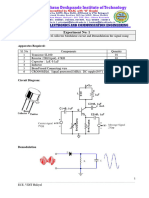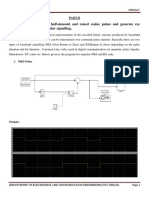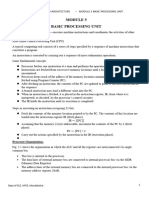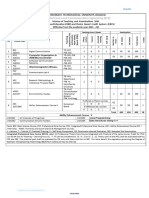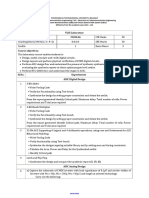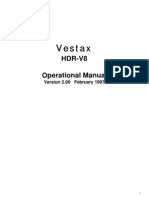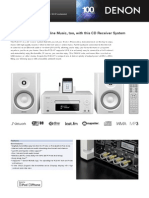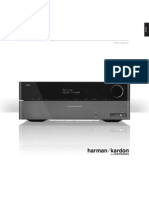21EC44 Syllabus
Uploaded by
Manjunath21EC44 Syllabus
Uploaded by
Manjunath03.10.
2022
VISVESVARAYA TECHNOLOGICAL UNIVERSITY, BELAGAVI
B.E: Electronics & Communication Engineering / B.E: Electronics & Telecommunication Engineering
NEP, Outcome Based Education (OBE) and Choice Based Credit System (CBCS)
(Effective from the academic year 2021 – 22)
IV Semester
Communication Theory
Course Code 21EC44 CIE Marks 50
Teaching Hours/Week (L:T:P: S) 3:0:0:1 SEE Marks 50
Total Hours of Pedagogy 40 Total Marks 100
Credits 3 Exam Hours 3
Course objectives: This course will enable students to
Understand and analyse concepts of Analog Modulation schemes viz; AM, FM., Low pass sampling
and Quantization as a random process.
Understand and analyse concepts digitization of signals viz; sampling, quantizing and encoding.
Evolve the concept of SNR in the presence of channel induced noise and study Demodulation of
analog modulated signals.
Evolve the concept of quantization noise for sampled and encoded signals and study the concepts of
reconstruction from these samples at a receiver.
Teaching-Learning Process (General Instructions)
These are sample Strategies, which teacher can use to accelerate the attainment of the various course
outcomes.
1. Lecture method (L) does not mean only traditional lecture method, but different type of teaching
methods may be adopted to develop the outcomes.
2. Show Video/animation films to explain evolution of communication technologies.
3. Encourage collaborative (Group) Learning in the class.
4. Ask at least three HOTS (Higher order Thinking) questions in the class, which promotes critical
thinking.
5. Adopt Problem Based Learning (PBL), which fosters students’ Analytical skills, develop thinking skills
such as the ability to evaluate, generalize, and analyze information rather than simply recall it.
6. Show the different ways to solve the same problem and encourage the students to come up with their
own creative ways to solve them.
7. Discuss how every concept can be applied to the real world - and when that's possible, it helps
improve the students' understanding.
Module-1
AMPLITUDE MODULATION: Introduction, Amplitude Modulation: Time & Frequency Domain
description, Switching modulator, Envelop detector.
DOUBLE SIDE BAND-SUPPRESSED CARRIER MODULATION: Time and Frequency Domain description,
Ring modulator, Coherent detection, Costas Receiver, Quadrature Carrier Multiplexing.
SINGLE SIDE–BAND AND VESTIGIAL SIDEBAND METHODS OF MODULATION: SSB Modulation, VSB
Modulation, Frequency Translation, Frequency Division Multiplexing, Theme Example: VSB Transmission
of Analog and Digital Television.
[Text1: 3.1 to 3.8]
Teaching- Chalk and talk method, Power Point Presentation.
Learning Self-study topics: Properties of the Fourier Transform, Dirac Delta Function.
Process RBT Level: L1, L2, L3
Module-2
ANGLE MODULATION: Basic definitions, Frequency Modulation: Narrow Band FM, Wide Band FM,
Transmission bandwidth of FM Signals, Generation of FM Signals, Demodulation of FM Signals, FM Stereo
Multiplexing, Phase–Locked Loop: Nonlinear model of PLL, Linear model of PLL, Nonlinear Effects in FM
03.10.2022
Systems. The Superheterodyne Receiver [Text1: 4.1 to 4.6]
Teaching- Chalk and talk method, Power Point Presentation, YouTube videos.
Learning Self-study topics: FM Broadcasting System [Ref1]
Process RBT Level: L1, L2, L3
Module-3
NOISE: Shot Noise, Thermal noise, White Noise, Noise Equivalent Bandwidth.
NOISE IN ANALOG MODULATION: Introduction, Receiver Model, Noise in DSB-SC receivers. Noise in AM
receivers, Threshold effect, Noise in FM receivers, Capture effect, FM threshold effect, FM threshold
reduction, Preemphasis and De-emphasis in FM (Text1: 5.10, 6.1 to 6.6)
Teaching- Chalk and talk method, Power Point Presentation, YouTube videos.
Learning Self-study topics: Mean, Correlation and Covariance functions of Random Processes
Process RBT Level: L1, L2, L3
Module-4
SAMPLING AND QUANTIZATION: Introduction, Why Digitize Analog Sources? The Low pass Sampling
process Pulse Amplitude Modulation. Time Division Multiplexing, Pulse-Position Modulation, Generation
of PPM Waves, Detection of PPM Waves. (Text1: 7.1 to 7.7 )
Teaching- Chalk and talk method, Power Point Presentation, YouTube videos.
Learning Self-study topics: T1 carrier systems [Ref1]
Process RBT Level: L1, L2, L3
Module-5
SAMPLING AND QUANTIZATION (Contd): The Quantization Random Process, Quantization Noise,
Pulse–Code Modulation: Sampling, Quantization, Encoding, Regeneration, Decoding, Filtering,
Multiplexing; Delta Modulation (Text1: 7.8 to 7.10), Application examples - (a) Video + MPEG
(Text1:7.11) and (b) Vocoders (refer Section 6.8 of Reference Book 1)
Teaching- Chalk and talk method, Power Point Presentation, YouTube videos.
Learning Self-study topics: Digital Multiplexing. [Ref1]
Process RBT Level: L1, L2, L3
Course Outcomes (Course Skill Set)
At the end of the course the student will be able to:
1. Understand the amplitude and frequency modulation techniques and perform time and frequency
domain transformations.
2. Identify the schemes for amplitude and frequency modulation and demodulation of analog signals
and compare the performance.
3. Characterize the influence of channel noise on analog modulated signals.
4. Understand the characteristics of pulse amplitude modulation, pulse position modulation and pulse
code modulation systems.
5. Illustration of digital formatting representations used for Multiplexers, Vocoders and Video
transmission.
Assessment Details (both CIE and SEE)
The weightage of Continuous Internal Evaluation (CIE) is 50% and for Semester End Exam (SEE) is 50%.
The minimum passing mark for the CIE is 40% of the maximum marks (20 marks out of 50). A student
shall be deemed to have satisfied the academic requirements and earned the credits allotted to each
subject/ course if the student secures not less than 35% (18 Marks out of 50) in the semester-end
examination (SEE), and a minimum of 40% (40 marks out of 100) in the sum total of the CIE (Continuous
Internal Evaluation) and SEE (Semester End Examination) taken together.
03.10.2022
Continuous Internal Evaluation:
Three Unit Tests each of 20 Marks (duration 01 hour)
1. First test at the end of 5th week of the semester
2. Second test at the end of the 10th week of the semester
3. Third test at the end of the 15th week of the semester
Two assignments each of 10 Marks
4. First assignment at the end of 4th week of the semester
5. Second assignment at the end of 9th week of the semester
Group discussion/Seminar/quiz any one of three suitably planned to attain the COs and POs for 20 Marks
(duration 01 hours)
6. At the end of the 13th week of the semester
The sum of three tests, two assignments, and quiz/seminar/group discussion will be out of 100 marks
and will be scaled down to 50 marks
(to have less stressed CIE, the portion of the syllabus should not be common /repeated for any of the
methods of the CIE. Each method of CIE should have a different syllabus portion of the course).
CIE methods /question paper is designed to attain the different levels of Bloom’s taxonomy as per
the outcome defined for the course.
Semester End Examination:
Theory SEE will be conducted by University as per the scheduled timetable, with common question
papers for the subject (duration 03 hours)
1. The question paper will have ten questions. Each question is set for 20 marks.
2. There will be 2 questions from each module. Each of the two questions under a module (with a
maximum of 3 sub-questions), should have a mix of topics under that module.
The students have to answer 5 full questions, selecting one full question from each module. Marks scored
out of 100 shall be proportionally reduced to 50 marks
Suggested Learning Resources:
Books
1. Simon Haykins & Moher, Communication Systems, 5th Edition, John Wiley, India Pvt. Ltd, 2010, ISBN
978 – 81 – 265 – 2151 – 7.
Reference Books
1. B P Lathi and Zhi Ding, Modern Digital and Analog Communication Systems, Oxford University Press.,
4th edition, 2010, ISBN: 97801980738002.
2. Simon Haykins, An Introduction to Analog and Digital Communication, John Wiley India Pvt. Ltd.,
2008, ISBN 978–81–265–3653–5.
3. H Taub & D L Schilling, Principles of Communication Systems, TMH, 2011.
You might also like
- VTU Network Analysis/Circuit Analysis - BEC304 - Solution - Model QP100% (4)VTU Network Analysis/Circuit Analysis - BEC304 - Solution - Model QP7 pages
- Lab Manual Ipcc Bec402 Principles of Communication Systems 22 05No ratings yetLab Manual Ipcc Bec402 Principles of Communication Systems 22 0529 pages
- VTU Advanced Communication LAB Manual 2020 - KLS VDIT HaliyalNo ratings yetVTU Advanced Communication LAB Manual 2020 - KLS VDIT Haliyal69 pages
- Simulate NRZ, RZ, Half-Sinusoid and Raised Cosine Pulses and Generate Eye Diagram For Binary Polar SignallingNo ratings yetSimulate NRZ, RZ, Half-Sinusoid and Raised Cosine Pulses and Generate Eye Diagram For Binary Polar Signalling10 pages
- ADE LAB UPDATED Manual-Draft 22 SCHEME - 23-24100% (1)ADE LAB UPDATED Manual-Draft 22 SCHEME - 23-2487 pages
- Network Analysis - ECE - 3rd Sem - VTU - Unit 1 - Basic Concepts - Ramisuniverse83% (6)Network Analysis - ECE - 3rd Sem - VTU - Unit 1 - Basic Concepts - Ramisuniverse20 pages
- Basic Electronics (BBEE103/BBEE203) - Introduction To Transducers (Module 5)No ratings yetBasic Electronics (BBEE103/BBEE203) - Introduction To Transducers (Module 5)111 pages
- EPC Lab (BE303) - 2022 Scheme !ST Cycle ExperimentsNo ratings yetEPC Lab (BE303) - 2022 Scheme !ST Cycle Experiments51 pages
- MODULE-5: Interfacing: Microcontroller Notes:18EE52No ratings yetMODULE-5: Interfacing: Microcontroller Notes:18EE5251 pages
- VTU E&CE (CBCS) 5th Sem Information Theory and Coding Full Notes (1-5 Modules)80% (5)VTU E&CE (CBCS) 5th Sem Information Theory and Coding Full Notes (1-5 Modules)691 pages
- Jain College of Engineering, Belagavi: Signals & Systems (18ec45) Question Bank For Cie - Iii50% (2)Jain College of Engineering, Belagavi: Signals & Systems (18ec45) Question Bank For Cie - Iii3 pages
- Solutions Manual to accompany An Introduction to Numerical Methods and AnalysisFrom EverandSolutions Manual to accompany An Introduction to Numerical Methods and Analysis5/5 (1)
- 2011 Eecs 142 Lect12 Intercept Point Gain Compression and BlockingNo ratings yet2011 Eecs 142 Lect12 Intercept Point Gain Compression and Blocking29 pages
- Range Rover L322 MY02 in Car Entertainment Handbook LRL0455ENG100% (1)Range Rover L322 MY02 in Car Entertainment Handbook LRL0455ENG51 pages
- CCP-1300, CCP-1310F, CCP-1400, CCP-1410FNo ratings yetCCP-1300, CCP-1310F, CCP-1400, CCP-1410F4 pages
- Ham Radio An Easy Guide For Beginners - Steve Markelo100% (5)Ham Radio An Easy Guide For Beginners - Steve Markelo10 pages
- Microwave Projects Andy Garter Ed pdf download100% (3)Microwave Projects Andy Garter Ed pdf download42 pages
- Stock Kembangan 5 Feb 2022 (Update) - ShareNo ratings yetStock Kembangan 5 Feb 2022 (Update) - Share10 pages
- W203 Sound Amplifier Control Unit Wiring DiagramNo ratings yetW203 Sound Amplifier Control Unit Wiring Diagram4 pages
- Aiwa nsx-sz80 nsx-sz83 Nsx-Aj80 Nsx-Sz80e Cx-Naj80 cx-nsz80 cx-nsz83 Cx-Nszj80e sx-wnsz80 Sx-Wnaj85 sx-s80 Service ManualNo ratings yetAiwa nsx-sz80 nsx-sz83 Nsx-Aj80 Nsx-Sz80e Cx-Naj80 cx-nsz80 cx-nsz83 Cx-Nszj80e sx-wnsz80 Sx-Wnaj85 sx-s80 Service Manual65 pages
- Electronic Communication: Amplitude Modulation (AM)No ratings yetElectronic Communication: Amplitude Modulation (AM)15 pages
- Performance Analysis of Ofdm-Im Over The Generalised FadingNo ratings yetPerformance Analysis of Ofdm-Im Over The Generalised Fading20 pages

